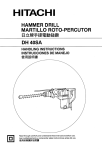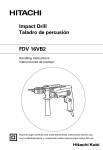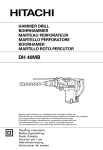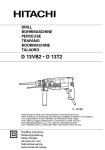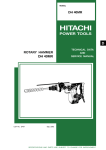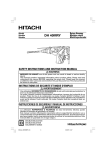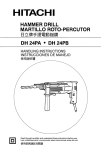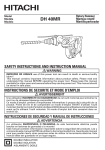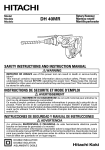Download Hitachi DH 40MR Power Hammer User Manual
Transcript
1 2 3 5 2 1 4 3 6 4 7 5 6 0 9 7 9 0 0 8 9 8 8 6 9 10 11 12 C A D B 1 8 E 13 14 15 J 5 C F H K 4 I 6 G 16 17 18 M J 19 J 20 K J P 73 7 mm 17 mm 2 Q N 21 K 22 L O English GENERAL OPERATIONAL PRECAUTIONS WARNING! When using electric tools, basic safety precautions should always be followed to reduce the risk of fire, electric shock and personal injury, including the following. Read all these instructions before operating this product and save these instructions. For safe operations: 1. Keep work area clean. Cluttered areas and benches invite injuries. 2. Consider work area environment. Do not expose power tools to rain. Do not use power tools in damp or wet locations. Keep work area well lit. Do not use power tools where there is risk to cause fire or explosion. 3. Guard against electric shock. Avoid body contact with earthed or grounded surfaces. (e.g. pipes, radiators, ranges, refrigerators). 4. Keep children away. Do not let visitors touch the tool or extension cord. All visitors should be kept away from work area. 5. Store idle tools. When not in use, tools should be stored in a dry, high or locked up place, out of reach of children. 6. Do not force the tool. It will do the job better and safer at the rate for which it was intended. 7. Use the right tool. Do not force small tools or attachments to do the job of a heavy duty tool. Do not use tools for purposes not intended; for example, do not use circular saw to cut tree limbs or logs. 8. Dress properly. Do not wear loose clothing or jewelry, they can be caught in moving parts. Rubber gloves and non-skid footwear are recommended when working outdoors. Wear protecting hair covering to contain long hair. 9. Use eye protection. Also use face or dust mask if the cutting operation is dusty. 10. Connect dust extraction equipment. If devices are provided for the connection of dust extraction and collection facilities ensure these are connected and properly used. 11. Do not abuse the cord. Never carry the tool by the cord or yank it to disconnect it from the receptacle. Keep the cord away from heat, oil and sharp edges. 12. Secure work. Use clamps or a vise to hold the work. It is safer than using your hand and it frees both hands to operate tool. 13. Do not overreach. Keep proper footing and balance at all times. 14. Maintain tools with care. Keep cutting tools sharp and clean for better and safer performance. Follow instructions for lubrication and changing accessories. Inspect tool cords periodically and if damaged, have it repaired by authorized service center. Inspect extension cords periodically and replace, if damaged. Keep handles dry, clean, and free from oil and grease. 15. Disconnect tools. When not in use, before servicing, and when changing accessories such as blades, bits and cutters. 16. Remove adjusting keys and wrenches. Form the habit of checking to see that keys and adjusting wrenches are removed from the tool before turning it on. 17. 18. 19. 20. 21. 22. Avoid unintentional starting. Do not carry a pluggedin tool with a finger on the switch. Ensure switch is off when plugging in. Use outdoor extension leads. When tool is used outdoors, use only extension cords intended for outdoor use. Stay alert. Watch what you are doing. Use common sense. Do not operate tool when you are tired. Check damaged parts. Before further use of the tool, a guard or other part that is damaged should be carefully checked to determine that it will operate properly and perform its intended function. Check for alignment of moving parts, free running of moving parts, breakage of parts, mounting and any other conditions that may affect its operation. A guard or other part that is damaged should be properly repaired or replaced by an authorized service center unless otherwise indicated in this handling instructions. Have defective switches replaced by an authorized service center. Do not use the tool if the switch does not turn it on and off. Warning The use of any accessory or attachment, other than those recommended in this handling instructions, may present a risk of personal injury. Have your tool repaired by a qualified person. This electric tool is in accordance with the relevant safety requirements. Repairs should only be carried out by qualified persons using original spare parts. Otherwise this may result in considerable danger to the user. PRECAUTIONS ON USING ROTARY HAMMER 䡬 Wear earplugs to protect your ears during operation. 䡬 Do not touch the bit during or immediately after operation. The bit becomes very hot during operation and could cause serious burns. 䡬 Before starting to break, chip or drill into a wall, floor or ceiling, thoroughly confirm that such items as electric cables or conduits are not buried inside. 䡬 Always hold the body handle and side handle of the power tool firmly. Otherwise the counterforce produced may result in inaccurate and even dangerous operation. 4 English SPECIFICATIONS Voltage (by areas)* (110V, 115V, 120V, 127V, 220V, 230V, 240V) Power input 950 W* Capacity Drill bit: 40 mm Core bit: 105 mm No load speed 240 – 480/min Full-load impact rate 1320 – 2650/min Weight (without cord, side handle) 6.5 kg * Be sure to check the nameplate on product as it is subject to change by areas. STANDARD ACCESSORIES (1) Case (Molded plastic) ................................................. 1 (2) Side Handle ................................................................. 1 (3) Stopper ........................................................................ 1 (4) Hexagon Bar Wrench (for 6 mm screw) ................... 1 (5) Hexagon Bar Wrench (for 5 mm screw) ................... 1 (6) Hexagon Bar Wrench (for 4 mm screw) ................... 1 (7) Hammer Grease A ...................................................... 1 Standard accessories are subject to change without notice. Taper shank adapter Application drill bit Morse taper (No. 1) Drill bit (taper shank) 11, 12.3, 12.7, 14.3, 14.5, 17.5 mm Adapter for SDS-plus shank bit (1) Drill bit (SDS-plus shank) OPTIONAL ACCESSORIES (sold separately) 1. Through-hole drilling (Rotation + Hammering) Outer diameter (mm) 3. Large dia. hole boring (Rotation + Striking) (Guide plate) (1) Drill bit (SDS max shank) Overall length (mm) 16 19 22 25 340, 540 320, 520 370, 570 28 32 38 40 2. Anchor hole drilling (Rotation + Hammering) (2) Adapter for SDS-plus shank bit (SDS max shank) (1) Center pin (2) Core bit (3) Core bit shank (1) Center pin 䢇 Applied to core bits from 38 mm to 105 mm 䢇 Applied to core bits 32 mm and 35 mm NOTE Do not use core bits 25 mm or 29 mm. (2) Core bit 䢇 External dia. 25, 29, 32, 35, 38, 45, 54, 64, 79, 94, 105 mm (with guide plate, not applicable to cores 25 mm or 29 mm) (3) Core bit shank 䢇 Applied to core bits above 38 mm 䢇 Applied to core bits below 35 mm 4. Drilling holes ...... For drilling metal and wooden materials Drill bit (Taper shank) (3) Cotter 13 mm drill chuck (13VLA) (2) Taper shank (1) Drill bit (taper shank) adapter External dia.: 11, 12.3, 12.7, (SDS max shank) 14.3, 14.5, 17.5 mm 5 Chuck wrench Chuck adapter (SDS max shank) English 5. Bolt placing operation with Chemical Anchor. (Rotation + Hammering) 䡬 Crushing concrete, chipping, digging, and squaring (by applying optional accessories) PRIOR TO OPERATION (Standard socket on the market) 6. Crushing (Hammering) (SDS max shank) 12.7 mm Chemical Anchor Adaptor 19 mm Chemical Anchor Adaptor (1) Bull point Overall length: 280, 400 mm 7. Groove digging and edging (Hammering) (1) Cold chisel Overall length: 280, 400 mm 8. Asphalt cutting (Hammering) (1) Cutter 9. Scooping Work (Hammering) (1) Scoop 10. Surface Roughing (Hammering) (1) Bushing Tool (2) Shank 11. Tamping (Hammering) (1) Rammer 150 × 150 mm (2) Shank 12. Syringe (for chip removal) 䡬 Hammer grease A 500 g (in a can) 70 g (in a green tube) 30 g (in a green tube) Optional accessories are subject to change without notice. APPLICATIONS 䡬 Drilling holes in concrete 䡬 Drilling anchor holes 1. Power source Ensure that the power source to be utilized conforms to the power requirements specified on the product nameplate. 2. Power switch Ensure that the power switch is in the OFF position. If the plug is connected to a power receptacle while the power switch is in the ON position, the power tool will start operating immediately, which could cause a serious accident. 3. Extension cord When the work area is removed from the power source, use an extension cord of sufficient thickness and rated capacity. The extension cord should be kept as short as practicable. 4. How to install tool NOTE For tools such as a bull point and a cold chisel, use only Hitachi genuine parts. (1) Clean, then smear the tool shank with the grease provided in the green tube (Fig. 1). (2) To attach the tool (SDS max shank), insert it into the hole until it contacts the innermost end of the hole as illustrated in Fig. 2. If you continue to turn the tool with slight pressure, you can feel a spot where there is a hitch. At that spot, pull the grip to the direction of an arrow mark and insert the tool all the way until it hits the innermost end. Releasing the grip reverts the grip and secures the tool in place. (3) Pull the tool to make sure it is locked completely. (4) To remove the tool, fully pull the grip in the direction of the arrow and pull out the tool. 5. Regulating the number of rotations and hammering (Fig. 3) This Rotary Hammer is equipped with a built-in electronic control circuit that can adjust and regulate the number of rotations and times of hammering. This Rotary Hammer can be used by adjusting the dial, depending upon the contents of operation, such as boring holes into fragile materials, chipping, centering, etc. The scale ‘1’ of the dial is designed for a minimum speed with the number of 240 rotations per minute and 1320 times of blow per minute. The scale ‘6’ is designed for a maximum speed with the number of 480 rotations per minute and 2650 times of blow per minute. CAUTION: Do not adjust the dial during operation. Doing so can result in injury because the Rotary Hammer must be held by only one hand, disabling the steady control of the Rotary Hammer. HOW TO USE THE ROTARY HAMMER 1. How to drill holes (Fig. 4) (1) Pull the switch trigger after applying the drill bit tip to the drilling position. 6 English (2) It is unnecessary to forcibly press the rotary hammer main body. It is sufficient to slightly press the rotary hammer to an extent that shavings are freely discharged. CAUTION Although this machine is equipped with a safety clutch, if the drill bit becomes bound in concrete or other material, the resultant stoppage of the drill bit could cause the machine body to turn in reaction. Ensure that the main handle and side handle are gripped firmly during operation. 2. How to chisel or crush (Fig. 5) By applying the drill bit tip to the chiseling or crushing position, operate the rotary hammer by utilizing its empty weight. Forcible pressing or thrusting is unnecessary. 3. When drilling at “rotation + hammering”: CAUTION: If you switch the selector lever during motor rotation, the tool can start to rotate abruptly, resulting in unexpected accidents. Be sure to switch the selector lever when the motor is at a complete stop. (1) Switching to “rotation + hammering” (a) Push the button, release lock and turn the selector lever clockwise. of the lever (b) Align ▲ of the selector lever and holder as illustrated in Fig. 6. (c) Release the button to lock the selector lever. NOTE: Turn the selector lever (do not push the button) to check if it is completely locked and make sure that it does not turn. 4. When chipping and chiseling at “hammering”: CAUTION: 䡬 If the selector lever is switched during motor rotation, the tool can start to rotate abruptly, resulting in unexpected accidents. Make sure to switch the selector lever when the motor is at a complete stop. 䡬 If the bull point or cold chisel is used at the position of ”rotation + hammering”, the tool can start to rotate, resulting in unexpected accidents. Make sure that they are used at the position of ”hammering”. (1) Switching to ”hammering” (a) Push the button, release lock and turn the selector lever counterclockwise. of the lever (b) Align ▲ of the selector lever and holder as illustrated in Fig. 7. (c) Release the button to lock the selector lever. NOTE: Turn the selector lever (do not push the button) to check if it is completely locked and make sure that it does not turn. (2) When fixing working positions of tools such as cold chisel, etc., (a) Push the button, release lock and turn the selector lever. Align ▲ of the selector lever and of the lever holder as illustrated in Fig. 8. (b) Release the button to lock the selector lever. (c) Turn the grip as illustrated in Fig. 9 and fix the tool to the desired working direction. (d) Switch the selector lever to “hammering” according to the procedures mentioned in the above item (1) and secure the position of the tool. 7 5. Install the stopper (Fig. 10) (1) Loosen the side handle and insert the straight portion of the stopper into the handle bolt hole. (2) Move the stopper to the specified position and rotate the grip of the side handle clockwise to fix the stopper. 6. Warming up (Fig. 11) The grease lubrication system in this unit may require warming up in cold regions. Position the end of the bit so makes contact with the concrete, turn on the switch and perform the warming up operation. Make sure that a hitting sound is produced and then use the unit. CAUTION When the warming up operation is performed, hold the side handle and the main body securely with both hands to maintain a secure grip and be careful not to twist your body by the jammed drill bit. DRILLING AND DRIVING-IN OPERATIONS FOR ANCHORS 1. When a taper shank adapter is used. (Fig. 12) (1) Install drill bit with taper shank in the taper shank adapter. (2) Turn the power on and drill a base hole to the depth sounded by indicating groove on the drill bit. (3) After cleaning out dust with a syringe, attach the plug to the anchor tip and drive in the anchor with a manual hammer. (4) To remove the drill bit (taper shank), insert the cotter into the slot of the taper shank adapter and strike the head of the cotter with a manual hammer supporting on a rest. (Fig. 13) USING DRILL CHUCK, CHUCK ADAPTER Note that this machine can be used at “rotation only” if separately sold parts such as drill chuck and chuck adapter are attached. Use it with the selector lever positioned at “rotation + hammering”. CAUTION: During operation, be sure to grip the handle and the side handle firmly to prevent your body from swaying. (1) Switching to “rotation + hammering” For switching to “rotation + hammering”, follow the same procedures mentioned in [3. When drilling at “rotation + hammering”]. (2) Attaching chuck adapter to drill chuck (Fig. 14) (a) Attach the chuck adapter to the drill chuck. (b) The SDS max shank of the chuck adapter is equivalent to the drill bit. Therefore, follow the same procedure as [How to install tool] for attaching and detaching. (3) Drilling (a) Even if you apply more-than-required pressure to the machine body, drilling can never be performed as quickly as you expect. Applying more force or pressure to the machine body than what is needed, on the contrary, damages the drill tip, resulting in the declined working efficiency and shortened life of this machine. (b) A drill can snap sometimes when drilling is almost finished. It is important to relax your thrusting pressure when drilling is nearing the end. English HOW TO HANDLE A CORE BIT When a core bit is used, large diameter holes and blind holes can be drilled. In this case, use optional accessories for core bits (such as a center pin and core bit shank) for more efficient operation. 1. Mounting CAUTION Prior to mounting a core bit, always disconnect the plug from the power supply receptacle. (1) Mount the core bit on the core bit shank. (Fig. 15) Before that, feed oil to the screw portion of core bit shank for easy dismounting. (2) Mount the core bit shank on the main body in the same manner as in mounting the drill bit and the bull point. (Fig. 16) (3) Insert the center pin into the guide plate until it reaches the extremity. (4) Fit in the guide plate by aligning its concaved portion with the core bit tip. When the position of the concave is shifted by turning the guide plate right or left, the guide plate never slips off even when the drill is used in a downward direction. (Fig. 17) 2. Drilling holes (1) Insert the plug into a receptacle. (2) A spring is built in the center pin. By straightly and gently pressing it to the wall or floor surface, the entire surface of the core bit tip attains contact to start the hole drilling job. (Fig. 18) (3) When the hole depth reaches approximately 5 mm, the hole position can be determined. Then remove the center pin and guide plate from the core bit and continue the hole drilling job. CAUTION When removing the center pin and guide plate, always disconnect the plug from the receptacle. 3. How to dismount the core bit 䡬 By holding the rotary hammer (with the core bit inserted) in an upward position, drive the rotary hammer to repeat impact operation two or three times, whereby the screw is loosened and the rotary hammer becomes ready for disassembly. (Fig. 19) 䡬 Remove the core bit shank from the rotary hammer, hold the core bit with one hand, and strongly strike the head of the SDS max shank portion of the core bit shank with a manual hammer two or three times, whereby the round head screw is loosened and the rotary hammer is ready for disassembly. (Fig. 20) HOW TO REPLACE GREASE This machine is of full air-tight construction to protect against dust and to prevent lubricant leakage. Therefore, the machine can be used without lubrication for long periods. Replace the grease as described below. 1. Grease replacement period After purchase, replace grease after every 6 months of usage. Ask for grease replacement at the nearest Hitachi authorized Service center. Proceed for replacement of grease. 2. Grease replenishment CAUTION Before replenishing the grease, turn the power off and pull out the power plug. (1) Remove the crank cover and wipe off the grease inside. (Fig. 21) (2) Supply 30g of Hitachi Electric Hammer Grease A (Standard accessory, contained in tube) to the crank case. (3) After replenishing the grease, install the crank cover securely. NOTE The Hitachi Electric Hammer Grease A is of the low viscosity type. If necessary purchase from an Hitachi authorized Service center. MAINTENANCE AND INSPECTION 1. Inspecting the tool Since use of a dull tool will degrade efficiency and cause possible motor malfunction, sharpen or replace the tool as soon as abrasion is noted. 2. Inspecting the mounting screws: Regularly inspect all mounting screws and ensure that they are properly tightened. Should any of the screws be loose, retighten them immediately. Failure to do so could result in serious hazard. 3. Maintenance of the motor The motor unit winding is the very “heart” of the power tool. Exercise due care to ensure the winding does not become damaged and/or wet with oil or water. 4. Inspecting the carbon brushes (Fig. 22) The Motor employs carbon brushes which are consumable parts. When they become worn to or near the “wear limit”, it could result in motor trouble. When an auto-stop carbon brush is equipped, the motor will stop automatically. At that time, replace both carbon brushes with new ones which have the same carbon brush Numbers shown in the figure. In addition, always keep carbon brushes clean and ensure that they slide freely within the brush holders. 5. Replacing carbon brushes Loosen the two set screws and remove the tail cover. Remove the brush caps and carbon brushes. After replacing the carbon brushes, tighten the brush caps securely and install the tail cover with securely tightening two set screws. 6. Service parts list A: Item No. B: Code No. C: No. Used D: Remarks CAUTION Repair, modification and inspection of Hitachi Power Tools must be carried out by an Hitachi Authorized Service Center. This Parts List will be helpful if presented with the tool to the Hitachi Authorized Service Center when requesting repair or other maintenance. In the operation and maintenance of power tools, the safety regulations and standards prescribed in each country must be observed. MODIFICATIONS Hitachi Power Tools are constantly being improved and modified to incorporate the latest technological advancements. Accordingly, some parts (i.e. code numbers and/or design) may be changed without prior notice. 8 English NOTE Due HITACHI’s continuing program of research and development, the specifications herein are subject to change without prior notice. 9 Español PRECAUCIONES GENERALES PARA OPERACIÓN 13. ¡ADVERTENCIA! Cuando utilice herramientas eléctricas, tome las medidas de seguridad básicas para reducir el riesgo de incendios, descargas eléctricas, y lesiones, incluyendo lo siguiente. Lea todas todas estas instrucciones antes de utilizar este producto y guárdelas. Para realizar roperaciones seguras: 1. Mantener el área de trabajo limpia, áreas y bancos de trabajo desordenados son causa de da ños personales. 2. Considerar el medio ambiente del área de trabajo. No exponer las herramientas eléctricas a la lluvia. No usar herramientas eléctricas en lugares mojados o húmedos. Mantener el área de trabajo bien iluminada. No utilice herramientas eléctricas cuando exista el riesgo de incendios o de explosión. 3. Protegerse contra descargas eléctricas. Evitar el contacto del cuerpo con las superficies puestas a tierra. (p. ej., tubos, radiadores, hornos de microondas, o refrigeradores.) 4. Mantener a los ni ños alejados. No dejar que los visitantes toquen las herramientas ni los cables de extensión. Todos los visitantes deberán mantenerse alejados del área de trabajo. 5. Guardar las herramientas que no se usen y ponerlos en lugares secos, altos o cerrados, fuera del alcance de los niños. 6. No forzar las herramientas, éstas trabajarán más y con mayor seguridad cuando cumplan con las especificaciones para las cuales fueron diseñadas. 7. Usar las herramientas apropiadas. No forzar pequeñas herramientas o accesorios a realizar el trabajo de herramientas de mayor potencia. No utilizar herramientas para otros propósitos para los cuales no fueron dise ñadas, por ejemplo, no utilizar sierras circulares para cortar ramas de árboles o troncos. 8. Vestir apropiadamente. No ponerse ropas que queden flojas ni tampoco joyas. Estas podrian quedar atrapadas en las partes móviles de las herramientas. Cuando se trabaje en exteriores, se recomienda el uso de guantes de goma y calzado que no resbale. 9. Usar gafas de protección. Usar también mascarillas contra el polvo si las condiciones de corte fuesen polvorientas. 10. Conecte un equipo colector de polvo. Si existen dispositivos para la conexión de equipos de extracción y recolección de polvo, cerciórese de queéstos estén conectados adecuadamente, y de utilizarlos en la forma correcta. 11. Cuidar del cable. Nunca lleve las herramientas colgando del cable, tampoco tire del cable para efectuar la desconexión de las herramientas. Mantener el cable alejado del calor, aceite y bordes agudos. 12. Asegurar la pieza de trabajo usando para ello abrazaderas o un tornillo. Esto es más seguro que usar las manos, ademas, ambas manos quedan libres para operar la herramienta. 14. 15. 16. 17. 18. 19. 20. 21. 22. No extenderse excesivamente para efectuar un trabajo. Mantener en todo momento un buen balance y base de apoyo. Mantener cuidadosamente las herramientas.Tener las siempre limpias y afiladas para obtener un mejor rendimiento y un funcionamiento más seguro. Seguir siempre las instrucciones para la lubricación y el cambio de accesorios. Inspeccionar periódicamente los cables de las herramientas y si estuviesen danãdos, hacer que los reparen técnicos o expertos. Inspeccionar periódicamente los cables de extensión y cambiarlos si estuviesen da ñados. Mantener los mangos secos, limpios, y libres de aceite y grasa. Desconectar las herramientas cuando no se usen, antes de repararlas, y cuando se cambien accesorios como por ejemplo, cuchillas, brocas, cortadores, etc. Quitar las cuñas y las llaves de tuercas. Acostumbrarse a comprobar si se han quitado las cu ñas y las llaves de tuercas antes de poner las harramientas en funcionamiento. Evitar puestas en funcionamiento sin fin alguno. No llevar las herramientas con los dedos en los inerruptores mientras que éstas cstán conectadas. Cuando se conecten las herramientas, cerciorarse de que los interruptores esten en la posición de desconectados. Para usos en exteriores usar cables de extensión. Cuando las herramientas vayan a ser usadas en exteriores, usar solamente cables de extensión diseñados para tal propósito. Estar siempre alerta y poner atención a lo que se está haciendo, usar el sentido común y no operar con la herramienta cuando se esté cansado. Comprobar las piezas dañadas. Antes de seguir con el funcionamiento de las herramientas, las piezas que estén dañadas deberán comprobarse cuidadosamente para determinar si pueden funcionar apropiadamente y cumplir con la función para las que fueron dise ñadas. Comprobar el alineamiento y agarrotamiento de piezas móviles, rotura de piezas, montura, y cualiquier otra anomalia que pudiese afectar al rendimiento de la herramienta. Cualquier pieza que estuviese da ñada deberá repararse apropiadamente o cambiarse en un centro de reparaciones autorizado, al menos que se indique, lo contrario en este manual de instrucciones. Procurar que los interruptores defectuosos los cambie un centro de reparaciones autorizado. No usar las herramientas si sus interruptores no funcionasen apropiadamente. Advertencia La utilización de cualquier accesorio o aditivo no recomendado en este manual de instrucciones puede conducir al riesgo de lesiones. En caso de avería, haga que su herramienta sea reparada por un técnico cualificado. Esta herramienta eléctrica está de acuerfdo con los requisitos de seguridad pertinentes. Las reparaciones solamente deberán realizarlas técnicos cualificadosutilizando piezas de repuesto originales. De lo contrario, el usuario podría lesionarse. 10 Español PRECAUCIONES AL USAR EL MARTILLO PERFORADOR 䡬 Usar protectores de oídos durante el trabajo. 䡬 No tocar la broca durante ni inmdiatamente después de trabajar, puesto que se pone ardiente y puede causar quemaduras serias. 䡬 Antes de empezar a romper, picar o perforar en una pared, suelo o techo, comprobar cuidadosamente que no hayan objetos empotrados, tales como cables o conductos eléctricos. 䡬 Sujetar siempre firmemente al asidero del cuerpo y el asidero lateral de la harrmienta. De lo contrario, la contrafuerza producida podría causar un funcionamiento impreciso e incluso peligroso. ESPECIFICACIONES Voltaje (por áreas)* (110V, 115V, 120V, 127V, 220V, 230V, 240V) Entrada 950 W* Capacidad Barrena: 40 mm Barrena tubular: 105 mm Velocidad sin carga 240 – 480/min Impacto a carga plena 1320 – 2650/min Peso (sin cable ni mango lateral) 6,5 kg * Verficar indefectiblemente los datos de la placa de características de la máquina, pues varían de acuerdo al país de destino. 2. Perforación de orificio de anclaje (Rotación + Martilleo) ACCESORIOS ESTANDAR Barrena (espiga cónica) (1) (2) (3) (4) Caja (Plástica) ............................................................ 1 Mango lateral ............................................................. 1 Tope ............................................................................ 1 Llave de barra hexagonal ......................................... 1 (para tornillos de 6 mm) (5) Llave de barra hexagonal ......................................... 1 (para tornillos de 5 mm) (6) Llave de barra hexagonal ......................................... 1 (para tornillos de 4 mm) (7) Grasa A para martillo ................................................ 1 Los accesorios estándar están sujetos a cambios sin previo aviso. ACCESORIOS FACULTATIVOS (de venta por separado) (3) Cortadora (1) Barrena Diàmetro externo: 11 12,3 12,7 14,3 14,5 17,5 mm (2) Adaptador de espiga cónica (Espiga SDS max) Adaptador de Barrena aplicable espiga cónica Cono Morse (N°. 1) Barrena (espiga cónica) 11 12,3 12,7 14,3 14,5 17,5 mm 1. Perforación por orificio (Rotación + Martilleo) Adaptador para barrena de espiga SDS-plus (1) Barrena (SDS plus vástago) (1) Barrena (Espiga SDS max) Diámetro externo (mm) 16 19 22 25 Longitud total (mm) 340 540 320 520 370 570 28 32 38 40 11 (2) Adaptador para barrena de espiga SDS-plus (Espiga SDS max) 3. Perforación de orificio de diámetro grande (Rotación + Martilleo) (1) Pasador (Placa guía) contral (3) Espiga de (2) Barrena barrena tubular (1) Pasador central 䢇 Aplicable a barrenas de 38 mm ~ 105 mm 䢇 Aplicable a barrenas de 32 mm y 35 mm NOTA No usar barrenas de 25 y 29 mm Español (2) Barrena 䢇 Diámetro externo 25 29 32 35 38 45 54 64 79 94 105 mm (Con placa guía no aplicable a barrenas de 25 y 29 mm) (3) Espiga de barrena tubular 䢇 Aplicable a barrenas de más de 38 mm 䢇 Aplicable a barrenas de menos de 35 mm 4. Perforación ......... Para taladrar materiales de metal y madera Adaptador del portabrocas (Espiga SDS max) 13 mm portabrocas (13VLA) (Espiga SDS max) Adaptador de anclaje químico de 12,7 mm Adaptador de anclaje químico de 19 mm 6. Romper (Martilleo) (1) Puntero Largo total: 280 400 mm 7. Excavar, ranurado y rebordes (Martilleo) (1) Cortafrio Largo total: 280 400 mm 8. Corte de asfalto (Martilleo) (1) Cortadora 9. Trabajos con cuchara (Martilleo) (Para utilizar en lugar de un pico) (1) Cuchara 10. Desbastadora de superficies (Martilleo) (1) Desbastadora (2) Barrena (1) Pisón 150 × 150 mm 12. Jeringa (extracción de resíduos) 13. Grasa A para martillo 500 g (en una lata) 70 g (en un tubo naranja) 30 g (en un tubo naranja) Los accesorios facultativos están sujetos a cambios sin previo aviso. APLICACIONES Liave de portabrocas 5. Trabajo de colocación de pernos para anclaje químico (Rotación + Martilleo) (Manguito adaptador a la venta el mercado) 11. Apisonamiento (Martilleo) (2) Barrena 䡬 Perforación de orificios en concreto 䡬 Perforación de orificios de anclaje 䡬 Romper hormigón, picar, cavar y cuartear (con accesorios opcionales). ANTES DE LA PUESTA EN MARCHA 1. Alimentación Asegurarse de que la alimentación de red que ha de ser utilizada responda a las exigencias de corriente especificadas en la placa de características del producto. 2. Conmutador de alimentación Asegurarse de que el conmutador de alimentación esté en la posición OFF (desconectado). Si la clavija está conectada en la caja del enchufe mientras el conmutador de alimentación esté en posición ON (conectado) las herramientas eléctricas empezarán a trabajar inmediatamente, provocando un serio accidente. 3. Cable de prolongación Cuando está alejada el área de trabajo de la red de alimentación, usar un cable de prolongación de un grosor y potencia normal suficiente. El cable de prolongación debe ser mantenido lo más corto posible. 4. Montaje de la herramienta NOTA Para usar herramientas tales como el puntero y cortafrío, usar siempre piezas genuinas Hitachi. (1) Limpiar y engrasar la espiga con la grasa provista (Fig. 1) (2) Para fijar la herramienta (espiga SDS max), insértela en el orificio hasta que entre en contacto con el extremo interior del mismo, como se muestra en la Fig. 2. Si continúa girando la herramienta con una ligera presión, podrá sentir un punto en el que note un obstáculo. En tal punto, tire del mango lateral en el sentido de la marca de flecha e inserte la herramienta completamente hasta que entre en contacto con el extremo interior. Al soltar el mango, éste volverá y asegurará la herramienta en su lugar. 12 Español (3) Tire de la herramienta y compruebe que se encuentre completamente bloqueada. (4) Para extraer la herramienta, tire completamente de la empuñadura en el sentido de la flecha y tire hacia afuera de la herramienta. 5. Regulación del número de rotaciones y martilleo (Fig. 3) Este martillo rotativo está provisto de un circuito de control electrónico que puede ajustar y regular el número de rotaciones y veces de martilleo. Este martillo rotativo podrá utilizarse ajustando el dial, dependiendo del contenido de la operación, como perforación en materiales frágiles, para cortar con escoplo, centrar, etc. La escala ‘1’ del dial corresponde a la velocidad mínima con un número de 240 rotaciones por minuto y 1320 veces de martilleo por minuto. La escala ‘6’ corresponde a la velocidad máxima con un número de 480 rotaciones por minuto y 2650 veces de martilleo por minuto. PRECAUCION: No ajuste el dial durante la operación. Si lo hiciese, podría dañarse porque tendría que sujetar el martillo rotativo con una sola mano, y perdería el control estable del mismo. MODO DE UTILIZACION 1. Taladrar orificios (Fig. 4) (1) Oprimir el interruptor de operación luego de apoyar la punta de la barrena en la posición de taladrar. (2) No es necesario presionar el cuerpo principal del martillo perforador. Es suficiente con empujar ligeramente el martillo de taladrar teniendo en cuenta que los materiales saltan libremente, al taladrar. PRECAUCION Aunque este aparato se equipa con un embrague de seguridad, si se atasca la barrena de taladrar en el hormigón u otro material semejante, puede pasar que, al atascarse la barrena, el cuerpo del martillo gire en dirección opuesta. Asegurarse entonces de que el mango principal y el lateral están bien empuñados durante el uso de esta herramienta. 2. Forma de picar o romper (Fig. 5) Aplicando la punta de la barrena en posición de picar o romper, hacer funcionar el martillo perforador aplicando su propio peso. No es necesario presionar o empujar excesivamente. 3. Cuando taladre con “rotación + martilleo”: PRECAUCION: Si cambia la palanca selectora mientras el motor esté girando, la herramienta puede comenzar a girar bruscamente, lo que puede resultar en accidentes inesperados. Cerciórese de cambiar la palanca selectora cuando el motor esté completamente parado. (1) Cambio a “rotación + martilleo” (a) Apriete el botón, desbloquee la palanca selectora y gírela en el sentido de las agujas del reloj. (b) Alinee la marca ▲ de la palanca selectora y del sujetador de palanca, tal como se muestra en la Fig.6. (c) Suelte el botón para bloquear la palanca selectora. 13 NOTA: Gire la palanca selectora (no apriete el botón) para comprobar que esté completamente bloqueada y cerciorarse de que no gire. 4. Para cortar con escoplo y triturar en el modo de “martilleo”: PRECAUCION 䡬 Si cambia la palanca selectora mientras el motor esté girando, la herramienta puede comenzar a girar bruscamente, lo que puede resultar en accidentes inesperados. Cerciórese de cambiar la palanca selectora cuando el motor esté completamente parado. 䡬 Si utiliza la barreta de punta o el cortafrío en la posición de “rotación + martilleo”, la herramienta puede comenzar a girar, lo que puede resultar en accidentes inesperados. Cerciórese de utilizarlos en la posición de “martilleo”. (1) Cambio a “martilleo” (a) Apriete el botón, desbloquee la palanca selectora y gírela en el sentido contrario a las agujas del reloj. (b) Alinee la marca ▲ de la palanca selectora y del sujetador de palanca, tal como se muestra en la Fig.7. (c) Suelte el botón para bloquear la palanca selectora. NOTA: Gire la palanca selectora (no apriete el botón) para comprobar que esté completamente bloqueada y cerciorarse de que no gire. (2) Cuando fije las posiciones de trabajo de herramientas tales como cortafrío, etc. (a) Apriete el botón, desbloquee la palanca selectora y gírela. (b) Alinee la marca ▲ de la palanca selectora y del sujetador de palanca, tal como se muestra en la Fig. 8. (c) Gire la palanca selectora como se muestra en la Fig.9 y fije la herramienta en la dirección de travajo deseada. (d) Cambia la palanca selectora a “martilleo” de acuerdo con los procedimientos mencionados en el ítem (1) anterior y asegure la posición de la herramienta. 5. Instalar el tope (Fig. 10) (1) Alfojar el mango lateral e insertar la parte recta del tope en el orificio del perno de manija. (2) Aflojar el mango lateral, y mover el tope a la posición especificada y rotar la empuñadura del mango lateral a la derecha para fijar el tope. 6. Calentamiento (Fig. 11) El sistema de lubricación de esta unidad puede requerir calentamiento en ciertas regiones. Coloque el extremo de la broca de forma que entre en contacto con el hormigón, ponga en ON el interruptor de alimentación principal de la unidad, y realice la operación de calentamiento. Cerciórese de que se produzca un sonido de martilleo, y después utilice la unidad. PRECAUCION Cuando haya realizado la operación de calentamiento, sujete con seguridad el mango lateral y el cuerpo principal con ambas manos para asegurar una buena sujeción y tenga cuidado de no torcer su cuerpo mediante una broca atascada. Español PERFORACION E INCRUSTACION DE ANCLAJES 1. Cuando se use un adaptador de espiga cónica (Fig. 12) (1) Instalar la barrena en el adaptador de espiga cónica. (2) Conectar el aparato y perforar un orificio base a una profundidad correspondiente a la ranura indicadora del tope en el orificio del perno de manija por la de la barrena. (3) Luego, limpiar el polvo con una jeringa, colocar el tapón en la punta del anclaje e instertar éste con un martillo manual. (4) Para quitar la broca (espiga ahusada), insertar la chaveta en la ranura del adaptador de la espiga ahusada y golperar la cabeza de la chaveta con un martillo. Usar apoyos como se muestra en la Fig. 13. UTILIZACIÓN DE PORTABARRENAS Y EL ADAPTADOR PARA PORTABARRENAS Tenga en cuenta que esta máquina podrá utilizarse en “rotación solamente” si le instala piezas vendidas aparte, tales como portabarrenas y adaptador para portabarrenas. Utilícela con la palanca selectora en la posición de ”rotación + martilleo”. PRECAUCION: Durante la operación, cerciórese de sujetar firmemente el mango y el mando lateral para evitar que su cuerpo se balancee. (1) Cambio a “rotación + martilleo” Para cambiar a “rotación + martilleo”, realice los mismos procedimientos que los mencionados en [3. Cuando taladre con “rotación + martilleo”]. (2) Fijación del adaptador para portabarrenas al portabarrenas (Fig. 14) (a) F i j e e l a d a p t a d o r p a r a p o r t a b a r r e n a s a l portabarrenas. (b) L a e s p i g a S D S m a x d e l a d a p t a d o r p a r a portabarrenas es equivalente a la barrena. Por lo tanto, para la instalación y el desmontaje, realice el mismo procedimiento que el mencionado en [Fijación de herramientas]. (3) Taladrado (a) Aunque aplique más de la presión requerida al cuerpo de la máquina, el taladrado no se realizará con mayor rapidez de la esperada. Por el contrario, la aplicación de mayor presión de la necesaria dañará la punta de la barrena, lo que resultará en reducción de la eficacia del trabajo y en acortamiento de la duración útil de esta máquina. (b) La barrena puede partirse a vece cuando el taladrado esté a punto de finalizarse. Es muy importante que usted reduzca la presión cuando esté a punto de terminar el taladrado. USO DE BARRENA TUBULAR Cuando se usa una barrena tubular, pueden perforarse orificios grandes y orificios ciegos. En este caso, hay que emplear los accesorios opcionales para barrenas tubulares (tales como el pasador central y la espiga de barrena tubular) para trabajar de modo más racional. 1. Montaje PRECAUCION Antes de montar una barrena tubular, siempre hay que desenchufar el aparato del tomacorriente de la pared. (1) C o l o c a r l a b a r r e n a t u b u l a r e n l a e s p i g a correspondiente (Fig. 15). Antes de ello, agregar aceite en la parte de rosca de la barrena tubular para facilitar el desmontaje. (2) Colocar la barrena tubular en el cuerpo principal del taladro del mismo modo que se hizo con la barrena y el puntero (Fig. 16) (3) Insertar el pasador central en la placa guía gasta que alcance la extremidad. (4) Colocar la placa quía alineando su parte cóncava con la punta de la barrena tubular. Cuando la posición de la parte cóncava se cambia, girando la placa guía a derecha o izquierda, ésta nunca debe salirse, aún cuando el taladro se use en dirección hacia abajo (Fig. 17). 2. Perforación (1) Enchufar el aparato en el tomacorriente de pared. (2) El pasador central tiene un resorte incluido y, presionándolo levemente y en forma recta, se pone en contacto toda la superficie de la punta de la barrena para comenzar a taladrar. (Fig. 18) (3) Cuando el orificio alcanza una profundidad de 5 mm la posición del orificio puede determinarse perfectamente. Luego, quitar el pasador central y la placa guía de la barrena tubular y continuar taladrando. PRECAUCION Cuando se quita el pasador central y la placa guía, siempre hay que desenchufar el aparato del tomacorriente. 3. Desmontaje de la barrena tubular (1) Sosteniendo el taladro (con la barrena tubular puesta) en posición invertida, accionar el taladro para que repita la operación de impacto dos o tres veces con ello, se afloja el tornillo y el taladro queda listo para desarmarse. (Fig. 19) (2) Quitar la espiga de la barrena tubular del taladro, sosteniendo la barrena tubular con una mano y golpear con fuerza la cabeza de la parte la espiga SDS max de la espiga de la barrena tubular, con un martillo manual dos o tres veces, para aflojar el tornillo de cabeza redonda, con lo cual, el taladro queda listo para desarmarse. (Fig. 20) CAMBIO DE GRASA Esta máquina es de construcción completamente cerrada, para evitar que entre polvo y haya fugas de lubricante. Por ello, la herramienta puede usarse sin lubricarse por largos periodos. Cuando so requiere cambiar la grasa, proceder como sigue: 1. Período de cambio de grasa: Luego de adquirir la herramienta, cambiarle la grasa cada 6 meses de uso. Consultar para ello con el agente de servicio Hitachi autorizado. Procedimiento de cambio de grasa. 14 Español 2. Rellenado de grasa PRECAUCION Antes de rellenar de grasa, desconectar el aparato y desenchufarlo del tomacorriente. (1) Quitar la cubierta de la manivela y limpiar la grasa interna. (Fig. 21) (2) Aplicar 30g de grasa para martillo eléctrico Hitachi tipo A (accesorio normales, contenida en tubo) en el cárter. (3) Luego de rellenar la grasa, instalar firmemente la cubierta de la manivela. NOTA La grasa A del martillo eléctrico Hitachi es del tipo de baja densidad. Si es necesario, siempre adquirir la grasa a un agente de servicio Hitachi autorizado. MANTENIMIENTO E INSPECCION 1. Inspección de la herramienta Ya que la utilización de una herramienta de corte embotada disminuirá la eficiencia de trabajo y podría causar desperfectos en el motor, afilar o cambiar las herramientas de corte tan pronto como se note abrasión en éstas. 2. Inspeccionar los tornillos de montaje: Regularmente inspeccionar todos los tornillos de montaje y asegurarse de que estén apretados firmemente. Si cualquier tornillo estuviera suelto, volver a apretarlo inmediatamente. El no hacer esto provocaría un riesgo serio. 3. Mantenimiento de motor: La unidad de bobinado del motor es el verdadero “corazón” de las herramientas eléctricas. Prestar el mayor cuidado y asegurarse de que el bobinado no se dañe y/o se humedezca con aceite o agua. 4. Inspeccionar los carbones de contacto (Fig. 22) El motor emplea escobillas de carbón que son partes consumibles. Cuando se gastan o están cerca del “limite de desgaste” pueden causar problemas al motor. Al equiparse la escobilla de carbón de parada automática, el motor se detendrá automáticamente en ese momento hay que proceder a cambiar ambas escobillas de carbón por la nuevas, que tienen los mismos números de escobillas de carbón como se muestra en la figura. Además siempre hay hay que mantener las escobillas de carbón limpias y asegurarse de que se muevan libremente en sus porta-escobillas. 5. Cambio de escobillas de carbón Quitar la cubierta de cola y luego aflojar el tornillo de fijación. Aflojando la tapa de escobilla, pueden quitarse las escobillas de carbón, al colocar las escobillas, apretar firmemente la tapa de escobillas y recolocar la cubierta con dos tornillos. 6. Lista de repuestos A: N°. ítem B: N°. código C: N°. usado D: Observaciones PRECAUCIÓN La reparación, modificación e inspección de las herramientas eléctricas Hitachi deben ser realizadas por un Centro de Servicio Autorizado de Hitachi. 15 Esta lista de repuestos será de utilidad si es presentada junto con la herramienta al Centro de Servicio Autorizado de Hitachi, para solicitar la reparación o cualquier otro tipo de mantenimiento. En el manejo y el mantenimiento de las herramientas eléctricas, se deberán observar las normas y reglamentos vigentes en cada país. MODIFICACIONES Hitachi Power Tools introduce constantemente mejoras y modificaciones para incorporar los últimos avances tecnológicos. Por consiguiente, algunas partes (por ejemplo, números de códigas y/o diseño) pueden ser modificadas sin previo aviso. OBSERVACION Debido al programa continuo de investigación y desarollo de HITACHI estas especificaciones están sujetas a cambio sin preaviso. 22 23 A B C 1 2 3 4 5 6 7 8 9 10 11 12 13 14 15 16 17 18 19 20 21 22 23 24 25 26 27 28 29 30 31 32 33 34 35 36 38 39 40 41 42 43 44 45 46 47 48 49 50 51 52 53 54 55 56 57 58 59 60 61 62 63 64 321-306 321-305 318-590 321-304 948-131 600-7DD 313-421 321-286 313-396 321-287 321-303 321-302 981-942 321-300 956-996 321-301 981-859 315-868 321-297 321-288 321-289 321-290 313-057 321-291 321-298 321-299 321-293 321-274 321-292 310-420 321-295 986-104 321-284 980-708 321-285 321-296 ———— 321-315 ———— 321-314 939-540 321-275 944-109 620-3DD 996-363 321-274 321-273 986-940 944-109 321-279 313-050 600-2DD 313-058 313-053 321-281 321-282 320-343 321-280 321-283 629-VVM 321-2377 944-525 313-078 1 1 1 1 1 1 2 1 1 1 1 1 4 1 1 1 1 1 1 1 1 1 4 1 1 1 1 1 1 1 1 1 1 1 1 1 1 1 1 1 1 1 1 1 1 1 1 4 1 1 1 1 1 1 1 10 10 1 1 1 1 1 1 D 6007DDUAV2S D8×20 M6×25 1AS-60 D6×6 3×3×8 6203DDCMPS2L S-40 M6×45 3×3×8 6002DDCMPS2L 629VVC2PS2L “11-22” A B C 65 66 67 68 69 70 71 72 73 74 75 76 77 78 79 80 81 82 83 1 83 2 83 3 85 86 1 86 2 86 3 313-080 971-786 ———— 983-162 313-079 321-309 311-229 321-308 321-307 873-095 321-310 321-311 321-312 321-276 939-299 321-319 620-1DD 302-429 360-591U 360-591E 360-591F 953-174 340-542C 340-542G 340-542E 1 1 1 5 1 1 1 1 1 1 1 1 1 1 1 1 1 1 1 1 1 2 1 1 1 86 4 87 88 89 90 92 93 94 95 96 97 98 99 100 101 102 103 104 105 106 1 106 2 106 3 107 108 1 108 2 109 1 109 2 110 111 112 113 501 502 503 504 505 340-542F 982-631 608-VVM 321-320 930-703 321-322 321-318 321-313 935-829 999-073 971-001 321-321 877-839 321-323 998-485 313-093 321-324 301-653 321-317 321-327 321-326 321-328 980-063 958-049 940-778 960-266 981-987Z 984-750 ———— 959-141 938-307 321-325 981-840 943-277 944-458 944-459 1 1 1 1 2 1 1 2 2 2 2 1 2 1 6 1 1 2 1 1 1 1 1 1 1 1 1 2 1 1 1 1 1 1 1 1 D M4×12 P-16 D2×10 M661 6201DDCMPS2L 110V-120V “87-90” 220V-230V 240V D5×55 110V “117, 118” 120V “117, 118” 220V-230V “117, 118” 240F 608VVC2PS2L “85, 86” M6×22 M5×10 M5×14 D4×20 110V 120V 220V-240V D8.2 D10.1 “SUI” D4×16 30G 3MM 4MM 5MM 24 208 Code No. C99118331 N Printed in Japan


























